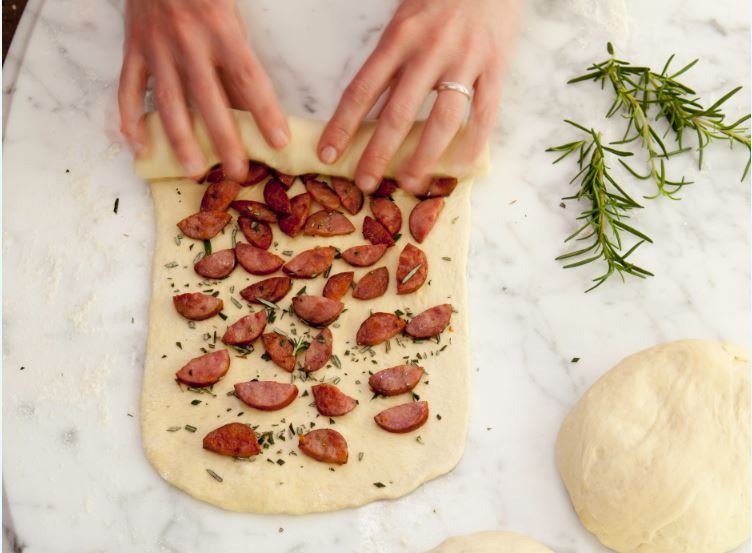Rolled Sausage Bread With Rosemary
Rolled Sausage Bread With Rosemary
"It wasn’t until I left Rio that Bráz Pizzaria came from São Paulo to Jardim Botânico. Now every time I travel home, I run to Bráz Pizzaria to devour pão de calabresa, a generous, well burnished round bread baked inside a tube mold. Even though this may be a classic in Italy, in Rio it is still a novelty. The appeal of this bread is not a mystery to cariocas: we love linguiça calabresa any way we can get it—and this bread is all about the sausage. Make sure to use a high-quality brand that you love. I took a cue for the dough for this bread from my friend Nick Malgieri, and this bread is the absolute best food for sharing with a large crowd. Okay, so you’re going to be full before you start eating—who cares? And if you have the chance to visit Bráz Pizzaria, I suggest you order the sausage bread as well as a bunch of different pizzas, because every pizza there is wonderful, especially the ones with Catupiry cream cheese."-Chef Leticia Moreinos SchwartzRecipe excerpted from My Rio de Janeiro: A Cookbook by Chef Leticia Moreinos Schwartz. Click here to purchase your own copy.

Ingredients
- 4 cup all-purpose flour
- 2 teaspoon (1 envelope) dry yeast
- 1 2/3 cup warm water
- 5 tablespoon olive oil
- 1 pound linguica, or other cured smoked pork sausage, cut into 1/4-inch-thick slices
- leaves of 3 sprigs of fresh rosemary
Directions
- Sift the flour and salt in a large bowl.
- In a small bowl, whisk the yeast into the water and let sit for about 5 minutes, until bubbling. Whisk in 3 tablespoons of the olive oil.
- Using a rubber spatula, make a well in the center of the flour. Pour in the yeast mixture and, using the spatula, stir in a circular motion, incorporating more flour as you stir. Drop the spatula and use your hands to knead the dough, making sure there are no dry bits of flour at the bottom of the bowl and the dough is smooth. Transfer the dough to a clean large bowl greased with oil. Cover with lightly oiled plastic wrap and let rest in a warm spot until it doubles in size, 1 to 2 hours, depending on the temperature of the room.
- Meanwhile, heat the remaining 2 tablespoons olive oil in a large skillet over medium heat. Add the sausage and cook, stirring frequently, until crisp, 8 to 10 minutes. Drain the sausage in a plate covered with paper towels and let cool completely.
- Invert the dough onto a floured surface and press it down to deflate. Divide the dough into 3 equal pieces. Working with one piece at a time, roll the dough out into a slightly rounded rectangular shape of about 14 x 8 inches, distribute a third of the sausage over it, and sprinkle with a few rosemary leaves. Starting at the far end of the dough, roll it toward you, jelly-roll style, pinching the edges when you get to the end. Roll out the second piece of dough and spread a second third of the sausage all over, followed by some rosemary leaves. Now, before you continue, place the first rolled piece of dough on top of the second piece of dough, toward the start, and roll it up around the first piece. Repeat with the third piece, placing the previous 2 rolls inside.
- By the time the 3 pieces of dough are stuffed and rolled, you will have a jelly-roll shape of about 3½ inches in diameter. Trim both ends.
- Grease an 8-cup tube pan with vegetable oil. Fit the dough inside the prepared pan seam side up. (If the length of the dough is longer than that of the mold, you can overlap. If it’s shorter, bring the dough back to the work surface and stretch it.) Cover with oiled plastic wrap and let rise rosemary, roughly chopped until doubled in size, 1 to 2 hours (or refrigerate overnight). When risen, the dough will be about 1 inch above the rim of the pan.
- When the dough is almost risen, preheat the oven to 425 degrees and set a rack in the lower third of the oven. Bake until the bread is well risen, golden, and firm and the internal temperature is about 200 degrees, about 30 minutes. Transfer the pan onto a wire rack and let it cool in the pan for about 10 minutes before unmolding. Use a serrated knife to cut it into thick slices.